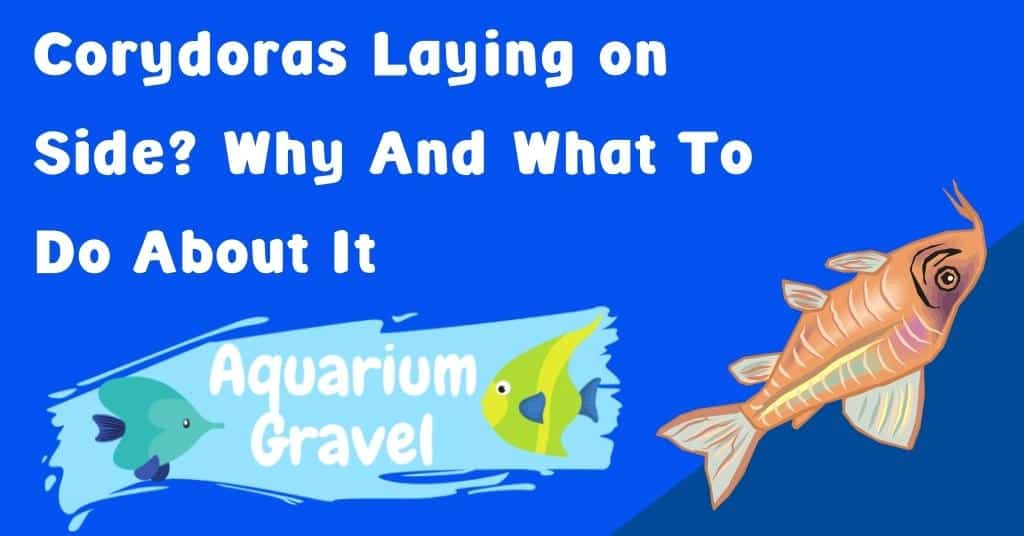Last Updated on March 6, 2022 by cmoarz
It’s absolutely frightening the first time you see one of your Corydoras laying on its side at the bottom of the tank. Even an experienced and long-time owner of corydoras can be caught off-guard by this strange behavior, which can seem to come out of nowhere. So, what’s going on and what should you do about it?

So, Why is my corydoras laying on its side?
Table of Contents
The first thing to keep in mind is that this is not inherently abnormal behavior for corydoras.
Corydoras spend a lot of time resting on the bottom of the tank, and often they will lay on their sides while doing so.
The behavior is more concerning when it appears to be out of the ordinary, for example, if the corydoras is usually very active and suddenly starts lying on its side a lot.
An example when this behavior is normal would be once a cory female has laid a batch of eggs.
Laying is exhausting work and she needs to rest to recover.
Normally she would just sit calmly on the bottom of the tank, however, when a female lays eggs it usually gets the males all riled up and they can make it difficult for her to rest.
So it’s not that uncommon to see her flip herself over and play dead. This allows her to get a little rest while tricking the males into leaving her alone for a bit.
And sometimes corydoras just like to let the current of the tank take them away, which often involves listing to one side or upside down completely.
Corydoras are notorious for sleeping in all sorts of weird positions.
A test that can indicate if there is actually something wrong is the chopstick test.
Simply gently poke the listing corydoras with a wooden chopstick (or another poking device). If she swims away and goes back to normal, she’s probably just resting by playing dead.
If she swims off, then shortly later resumes the position, let her rest for a bit; she’ll get up when she’s good and ready.

An indication that something is wrong
Listing, while normal behavior, can also indicate something is wrong with the fish.
If your corydoras lays on its side for more than a few hours, intermediate or not, It could indicate there is a problem.
There are a few things that could be wrong:
- The fish is injured
- The water parameters may be off (always test)
- The fish has hit the glass and “knocked itself out” (Rare but I’ve seen this happen)
- Bloating
- Depression (Corydoras are social fish and need at least 3 of their own species)
- General stress
Signs that could indicate something is wrong:
- Long periods of listing to sides, swimming in circles, floating upside down, or coming to the surface more often than normal.
- Lethargy in general, Slow to move and react to the poking stick
- Clear signs of bloating, such as a swollen belly
- Rapid gill movements (not always an indicator)
- lack of appetite
- Signs of physical damage such as a cut, white spots or torn fins
If your corydoras displays any of these symptoms, it is best to take her to a qualified fish vet for diagnosis and treatment or to self administer medications based on the symptoms.
How to help a listing corydoras
If your corydoras is just resting by playing dead and everything seems normal, there is no need to do anything.
However, if the corydoras is not responding to the chopstick test or displays other signs of illness, there are a few things you can do to help:
First, check the water parameters and make sure they are in the correct range.
If they are not, correct them.
Next, try performing a water change.
A water change can help to improve the overall health of your fish and may help to resolve the problem.
If there is still no improvement, you may need to administer medication.
There are a variety of medications available on the market that can help to treat different illnesses.
Always consult with a qualified fish vet or professional aquarist before administering any medications.

Bottom Line
In our experience, it’s usually nothing more than corydoras being lazy little fish that they are.
Just give them some time and don’t overreact too soon. An overreaction could see a healthy fish being disposed of (which does happen!).
Usually, signs of illness will be more pronounced and obvious.
However, if you’re ever in doubt, it’s always best to take your fish to a qualified fish professional diagnosis and treatment.
About
Owner of AquariumGravel.com and also owner of actual Aquarium Gravel believe it or not! ;). Setting up beautiful aquarium sceneries and habitats since I was very young. Enjoy!
- Web |
- More Posts(290)

